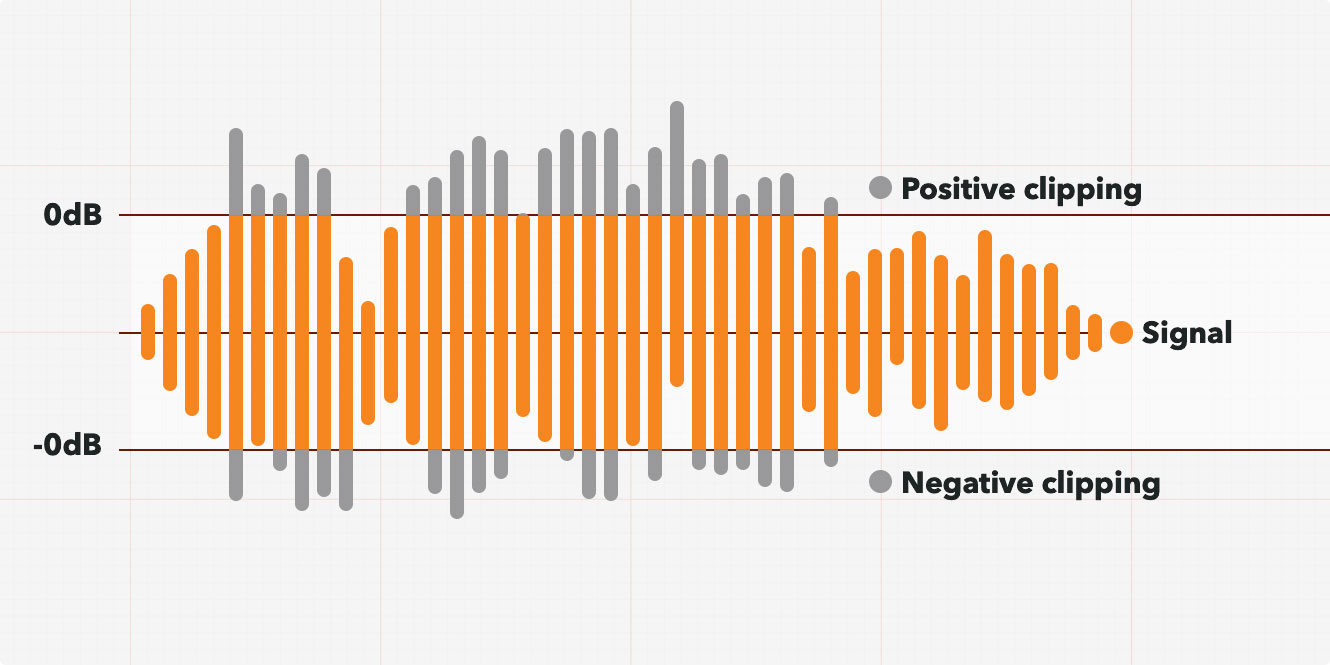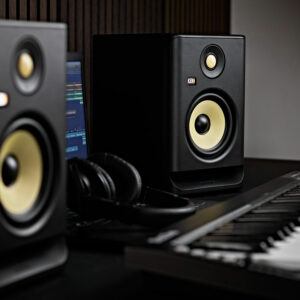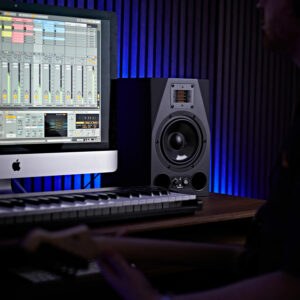Featured image: Creative Commons License by Victorgrigas
Encountering audio clipping is a familiar scenario in the recording studio, often signalled by the urgent glow of a red light in our digital audio workstation (DAW), on audio interfaces, or on mixing consoles. Now you’re jumping to your faders and volume knobs to reduce the volume to solve the issue. But let’s take things back to basics. What is audio clipping?
Whether you’re a musician or a producer, understanding the concept of audio clipping is essential in maintaining the sonic integrity of your work. Without careful management, clipping can severely degrade your audio quality, resulting in a poor listening experience for your fans. Fortunately, in this article, we’ll guide you through what exactly audio clipping is and how you can fix it.
Main takeaways
| What is audio clipping? | Your audio will clip when the signal exceeds your system's capabilities; this cuts off part of your waveform and results in some unpleasant distortion. |
| How do I fix it? | You can avoid audio clipping with proper gain staging. If it does find its way into your mix, though, it can be hard to fix without advanced audio restoration software. |
What is audio clipping?
Audio clipping is what occurs when an audio signal exceeds what a system can handle, leading to parts of the waveform being abruptly cut off. This typically happens if you record with levels too high or push your equipment’s limits, like the master fader in a digital audio workstation (DAW) going into the red zone.
Clipping fundamentally alters the shape of the audio waveform, transforming it into something that sounds harsh and distorted. While some forms of clipping, like saturation, can be creatively used to enrich a mix, unintentional clipping – due to improper gain staging – is generally undesirable.
It not only distorts the sound in an unpleasant way but also compromises the integrity of the audio quality, making it a critical issue to manage in both analog and digital audio production environments.

Digital vs. analog clipping
The contrast between analog and digital clipping is stark and significant. Analog clipping gently saturates audio that surges past the 0 dB threshold. This form of clipping introduces musical harmonics that enrich the original signal, creating a sound that’s warm and pleasing to the ears. It operates under a different ceiling compared to digital clipping, allowing for a bit more leeway before reaching distortion.
Digital clipping is unforgiving and abrupt. Once the audio signal exceeds 0 dB digitally, it gets sharply truncated, cutting off the peaks of the audio which leads to a form of distortion that can be harsh and unpleasing. This stark cutoff results in a loss of the nuanced details of the sound, often leaving a brittle and jarring effect.
However, the digital domain offers tools to mimic the warmer, more forgiving nature of analog clipping with plugins that simulate analog-style clipping, bridging the gap between digital precision and analog warmth.
How to avoid audio clipping
Avoiding clipping is crucial in creating pristine audio. The golden rule? Proper gain staging from the start. This means setting up your recording levels so that they’re strong enough to capture all the nuances of your sound, without tipping into the red zone on your equipment or in your digital audio workstation (DAW).
It’s about finding that sweet spot where the signal is clean and strong, but not so loud that it distorts. This principle applies across the board, whether you’re working in the analog or digital domain.
Despite your best efforts, sometimes clipped audio sneaks into the mix, especially if you’re working with recordings made under less-than-ideal conditions or with less experienced engineers. And yes, sometimes a performance is so compelling that it’s tempting to overlook a few clipped peaks.
However, dealing with already clipped audio can be a challenge. Clipping is a destructive process that alters the original audio signal permanently. While advanced audio restoration software can sometimes salvage clipped audio, it’s not a surefire fix and can be expensive.
The most effective way to manage clipping is to avoid it from the get-go. If you’re faced with irreparable clipped audio, consider re-recording. It might seem like a step back, but you’ll be thankful when you have a clean, unclipped recording that lays the foundation for all the subsequent stages of production.
What does audio clipping sound like?
Fuzzy, brash, brittle, woolly. Essentially, when audio is clipped and non-musical frequencies become amplified, you’ll get a very “harsh” sound.
But interestingly, not all clipping is unwelcome. All forms of distortion are clipping in some way or other. The clipping in guitar amplifiers and pedals, for example, produces a harmonically rich distortion that’s extremely musical and a crucial sound of the electric guitar.
Additionally, intentional clipping plays an important role in the mixing process, too. Engineers use clipping plugins to tame the highest peaks of audio files, subtly reducing dynamic range. This technique can help “glue” the elements of a mix together, especially when striving for a loud, cohesive sound without unwanted spikes.
By carefully controlling transients, clipping preserves valuable headroom in the mix.
It’s not all bad!
As we’ve just touched on, clipping isn’t always the bad guy. Intentionally applied, it generates desirable audio effects such as distortion, overdrive, and saturation. Specifically, soft clipping has added colour and warmth to mixes since the ’80s, avoiding the severe peaks associated with standard clipping.
It can happen through limiting, compression, or distortion – essentially, any process pushing the signal beyond its digital or analog limits can result in clipping.
Distortion
 Distortion is a clipping technique that augments the sound quality of recordings, especially in rock genres, by providing extended sustain compared to more subdued clipping effects like overdrive. Harmonic distortion introduces additional harmonics to the original sound as it undergoes distortion, enriching the sound.
Distortion is a clipping technique that augments the sound quality of recordings, especially in rock genres, by providing extended sustain compared to more subdued clipping effects like overdrive. Harmonic distortion introduces additional harmonics to the original sound as it undergoes distortion, enriching the sound.
Consequently, the sound is thickened and enhanced with new, harmonically related elements. You’ll find this method of clipping everywhere in guitar equipment, specifically pedals and amplifiers to deliver the distorted tones that are synonymous with rock and heavier genres.
Overdrive
Overdrive clipping emulates the sound of distortion through an amplifier when the sound begins to clip and distort, typically when the amplitude exceeds the amplifier’s threshold. This form of clipping is fairly mild and can give recordings subtle colour.
Functioning as a type of analog-style soft clipping, overdrive does not introduce excessive harmonic additions but instead offers the signal a slight boost. It simulates the effect of transmitting a signal through an analog tube amplifier, thereby enhancing thickness without significantly altering the timbre.
Saturation
The typical saturation sound is a blend of compression and traditional soft clipping, impacting audio signals by enhancing their punch, loudness, and warmth. This subtler form of distortion is primarily achieved through driving audio signals into tape and tube equipment where increasing the input drives greater signal saturation.
Saturation smears your audio signals, harmonically spreading across the frequency spectrum to soften transient peaks and frequencies.
Fuzz
 Fuzz is recognised for its distinctive, warm, and buzzy tonal quality, having gained prominence in the ’90s and within the psychedelic rock genre. The effect is reminiscent of early guitar amps, particularly when they malfunctioned!
Fuzz is recognised for its distinctive, warm, and buzzy tonal quality, having gained prominence in the ’90s and within the psychedelic rock genre. The effect is reminiscent of early guitar amps, particularly when they malfunctioned!
Fuzz is achieved through the hard clipping of analog transistors, yielding a noisy yet somewhat “broken” sound.
Fuzz distortion has been adopted across various musical styles, enhancing instruments from electric guitars to drums, albeit with careful attention to potential muddiness in lower frequency ranges.
Soft clipping
Soft clipping distorts a signal to add colour and warmth while mitigating the abrasive characteristics typically associated with clipping. This approach involves rounding off waveforms that exceed a 0 dB threshold, thereby smoothing out the signal for a more pleasant auditory experience.
Unlike hard clipping, soft clipping gradually saturates the signal amplitude along a gentle curve, producing fewer harsh harmonic frequencies. Effective use of soft clipping can enhance the perceived loudness of an audio signal (without actual volume increase), diminish peaks, add crunch and edge, and amplify the higher frequencies of the audio.
FAQs
What does clipping do to audio?
Audio clipping is a form of distortion which chops off the highest levels of a waveform. When a signal exceeds the maximum levels, the audio is clipped and the sine waves become square waves, resulting in an unpleasant sound that significantly reduces audio quality.
Does clipping destroy speakers?
Clipping analog outputs can damage speakers by pushing them beyond their limits. When a clipped signal passes through speakers, the distortion pushes the physical speaker components beyond their maximum, causing overheating, even if the speaker isn’t at full output.
What is the difference between distortion and clipping?
Distortion alters a signal with new overtones and is used as a creative tool for musical effect, whereas clipping is a harsher form of distortion that occurs when a signal exceeds a system’s maximum capacity. Clipping happens when there’s no more headroom, leading to a truncated and unpleasant sound.
Final thoughts
If your DAW channel faders clip from time to time, don’t panic! Judging first with your ears is crucial. If there’s no audible distortion, there’s no need to tweak everything immediately.
However, slamming your master output above 0dBFS or above, it’s a different story. You’ll want to pull everything down a bit. The exact amount of headroom you’ll need can vary, but it’s all about finding that sweet spot.
So now you know what audio clipping is, hopefully, you know how to avoid it and when it can be useful!
Want to learn more? Check out our comprehensive guide to DAWs, or for something more hardware-based, browse our favourite audio interfaces at the moment.













0 Comments